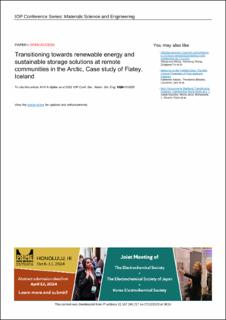| dc.contributor.author | Hjallar, Milla | |
| dc.contributor.author | Vidisdottir, Elena Dis | |
| dc.contributor.author | Gudmestad, Ove Tobias | |
| dc.coverage.spatial | Island | en_US |
| dc.date.accessioned | 2024-03-25T08:33:33Z | |
| dc.date.available | 2024-03-25T08:33:33Z | |
| dc.date.created | 2023-12-26T14:51:01Z | |
| dc.date.issued | 2023 | |
| dc.identifier.citation | Hjallar, M.R.A., Víðisdóttir, E.D. & Gudmestad, O.T. (2023) IOP Conference Series: Materials Science and Engineering, 1294, 012035 | en_US |
| dc.identifier.issn | 1757-8981 | |
| dc.identifier.uri | https://hdl.handle.net/11250/3123979 | |
| dc.description.abstract | The need for transitioning towards renwable energy and sustainable storage solutions is particularly challenging for remote communities in the Arctic, located far away from the electricity grid. This paper explores the potential for use of renewable energy on the remote island of Flatey, Iceland, which currently relies on two diesel aggregates for power. The primary goal is to assess the feasibility of transitioning from fossil fuels to renewable energy sources, such as solar or wind power, to meet the island's variable energy demand while reducing its environmental impact. With a year-around population of 5 and with a considerably increased energy consumption during vacation times, due to more population, Flatey's annual energy consumption is ~ 209.000 kWh, peaking in July at ~ 25.000 kWh. This fluctuation requires an adaptable and resilient energy infrastructure. The paper examines the viability of Flatey as a self-sufficient renewable energy provider. The study considers the island's energy requirements, consumption patterns, and geographical constraints, while also evaluating technical, economic, and social factors that may influence renewable energy adaption. This paper, thereafter, investigates the feasibility of achieving energy self-sufficiency on the small island of Flatey. Different energy storage options is considered, focusing on battery storage, underground solar power/energy storage, and hydrogen storage. | en_US |
| dc.language.iso | eng | en_US |
| dc.publisher | IOP Publishing | en_US |
| dc.rights | Navngivelse 4.0 Internasjonal | * |
| dc.rights.uri | http://creativecommons.org/licenses/by/4.0/deed.no | * |
| dc.subject | fornybar energi | en_US |
| dc.title | Transitioning towards renewable energy and sustainable storage solutions at remote communities in the Arctic, Case study of Flatey, Iceland | en_US |
| dc.type | Peer reviewed | en_US |
| dc.type | Journal article | en_US |
| dc.description.version | publishedVersion | en_US |
| dc.subject.nsi | VDP::Teknologi: 500 | en_US |
| dc.source.pagenumber | 12 | en_US |
| dc.source.volume | 1294 | en_US |
| dc.source.journal | IOP Conference Series: Materials Science and Engineering | en_US |
| dc.identifier.doi | 10.1088/1757-899X/1294/1/012035 | |
| dc.identifier.cristin | 2217581 | |
| cristin.ispublished | true | |
| cristin.fulltext | original | |
| cristin.qualitycode | 1 | |

